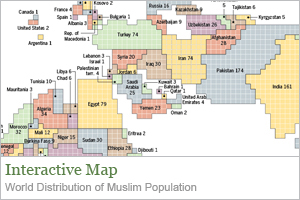A Report on the Size and Distribution of the World's Muslim Population
Of the total Muslim population, 10-13% are Shia Muslims and 87-90% are Sunni Muslims. Most Shias (between 68% and 80%) live in just four countries: Iran, Pakistan, India and Iraq.
These are some of the key findings of Mapping the Global Muslim Population: A Report on the Size and Distribution of the World's Muslim Population, a new study by the Pew Research Center's Forum on Religion & Public Life. The report offers the most up-to-date and fully sourced estimates of the size and distribution of the worldwide Muslim population, including sectarian identity.
Previously published estimates of the size of the global Muslim population have ranged widely, from 1 billion to 1.8 billion. [2] But these commonly quoted estimates often have appeared without citations to specific sources or explanations of how the figures were generated.
The Pew Forum report is based on the best available data for 232 countries and territories. Pew Forum researchers, in consultation with nearly 50 demographers and social scientists at universities and research centers around the world, acquired and analyzed about 1,500 sources, including census reports, demographic studies and general population surveys, to arrive at these figures - the largest project of its kind to date. (See Methodology for more detail.)
The Pew Forum's estimate of the Shia population (10-13%) is in keeping with previous estimates, which generally have been in the range of 10-15%. Some previous estimates, however, have placed the number of Shias at nearly 20% of the world's Muslim population. [3] Readers should bear in mind that the figures given in this report for the Sunni and Shia populations are less precise than the figures for the overall Muslim population. Data on sectarian affiliation have been infrequently collected or, in many countries, not collected at all. Therefore, the Sunni and Shia numbers reported here are expressed as broad ranges and should be treated as approximate.
These findings on the world Muslim population lay the foundation for a forthcoming study by the Pew Forum, scheduled to be released in 2010, that will estimate growth rates among Muslim populations worldwide and project Muslim populations into the future. The Pew Forum plans to launch a similar study of global Christianity in 2010 as well. The Pew Forum also plans to conduct in-depth public opinion surveys on the intersection of religion and public life around the world, starting with a 19-country survey of sub-Saharan Africa scheduled to be released later this year. These forthcoming studies are part of a larger effort - the Global Religious Futures Project, jointly funded by The Pew Charitable Trusts and the John Templeton Foundation - that aims to increase people's understanding of religion around the world.
Download the full report PDF (62 pages, 10MB)
Footnotes
[1] For a definition of “territories,” see the methodology.
[2] See, for example, CIA World Factbook; Foreign Policy magazine, May 2007; Who Speaks for Islam: What a Billion Muslims Really Think, 2008; Adherents.com; and IslamicPopulation.com.
[3] See, for example, IslamicWeb.com; "Shia Muslims in the Middle East,” Council on Foreign Relations, June 2006; and “The Revival of Shia Islam,” Vali Nasr speaking at a Pew Forum event, July 2006.
Map: Distribution of Muslim Population by Country and Territory »
¤ ¤ ¤ ¤ ¤
Source: http://pewforum.org/docs/?DocID=450

























